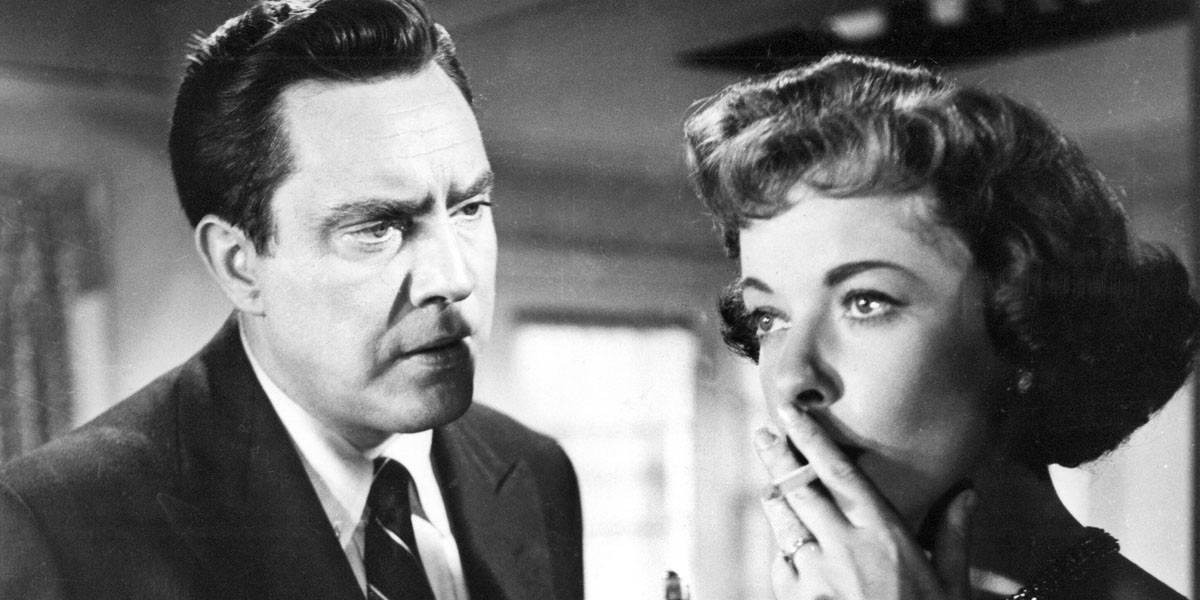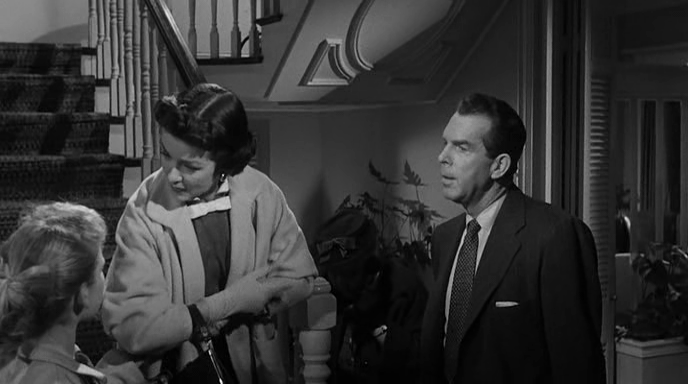
Ida Lupino’s The Bigamist is an extraordinarily unconventional film, especially for its 1953 release. While contemporary audiences were not averse to depictions of discontentment with the lifestyle and roles that were supposed to be fulfilling them, mainstream Hollywood films had their own way of conducting this kind of critique. This was not the way of Lupino and her independent production company, The Filmakers. Like The Bigamist, Douglas Sirk’s There’s Always Tomorrow (1956) offers a critique of marriage and monogamy from the perspective of a dissatisfied husband, but ultimately the two films come to different conclusions on the institution of marriage. Whereas Sirk emphasizes the entrapment and hollowness of bourgeois marriage, The Bigamist instead directs its criticism at patriarchal, institutional monogamy’s failure to accommodate complicated emotional, work, and financial needs and responsibilities. A comparison of the Lupino and Sirk films highlights what Lupino’s outsider approach added to American cinema’s criticism of postwar conformism.
Three’s Company: Lupino, Fontaine and Young
After getting her start as an actress in the 1930s, Lupino became “the only woman to direct films in Hollywood in the immediate postwar era.”[i] She co-founded The Filmakers with Collier Young, screenwriter and co-producer of The Bigamist, and Malvin Wald. Their intention was to make serious, documentary-style films about social problems, providing a realistic and complex depiction of marginalized topics. In The Bigamist, an adoption agent, Mr. Jordan (Edmund Gwenn), discovers Harry Graham (Edmond O’Brien) is married to more than one woman while investigating his personal life to establish suitability for fatherhood. The film then switches perspective to Harry, who gives an account through flashback of how he got into this unwonted situation.
The Bigamist is intent on depicting Harry’s position as sympathetic. His wife, Eve (Joan Fontaine), has reacted to her inability to have children by throwing herself into a business partnership with him, resulting in their estrangement and his subsequent involvement with another woman, Phyllis (Lupino herself). When Phyllis becomes pregnant, he asks Eve for a divorce. Eve, however, has decided that she’s ready to adopt, which, in 1953, was impossible without the respectability that came with wearing a wedding ring.[ii]
At first glance, The Bigamist appears to be yet another film putting forth a plea for understanding for one hapless, misguided man. However, the casting of Fontaine and Lupino in their roles offers a critique of postwar sexual mores: Young was Lupino’s ex-husband and Fontaine’s husband at the time.
Lupino and Young, in their own way, turned their attention to aspects of their own lives to produce a distinctive challenge to the postwar American ideal of heteronormative marriage.
The couples were so close, in fact, that Young and Fontaine were named the godparents of Lupino’s child with her new husband, although she had become pregnant while still technically married to Young.[iii] Considering this, the film’s casting can be seen as a reflection of its makers’ commitment to an enlightened attitude toward the topics of adultery and out-of-wedlock pregnancy. Lupino and Young, in their own way, turned their attention to aspects of their own lives to produce a distinctive challenge to the postwar American ideal of heteronormative marriage.
Sirk, sadness and socialization
Sirk’s There’s Always Tomorrow offers its own critique of this ideal. His popular melodramas appeared to give 1950s audiences everything they wanted in the way of white middle-class lifestyle aspirationalism: the picket fence and nuclear family. Through his cinematic form, however, he also criticized these values. In There’s Always Tomorrow, Clifford Groves (Fred MacMurray) has everything that he’s supposed to want: three healthy children with thriving social lives, a homemaker wife, Marion (Joan Bennett), who runs the household with fanatical devotion and managerial efficiency. The only problem is that the mild-mannered breadwinner is an alien in his own home. His children are preoccupied with their own lives, and Marion’s focus is the children, not him.
Like The Bigamist, There’s Always Tomorrow portrays Cliff’s adulterous impulses (towards a former employee, Norma, played by Barbara Stanwyck) in these circumstances with sympathy. In both films, the men try to revive some sense of romance with their wives, only to be brushed off. We are shown that their motivation for adultery isn’t lust, but the need to love and be loved. The resemblances between their lives end there, however. Cliff is having a crisis of disillusionment with the ideals he thought he believed in, as represented by his marriage. Harry’s marriage in no way resembles the societal ideal: his wife is infertile, and their marriage has turned into a business partnership. And while the focus of the films seems to be the male protagonists’ problems and inner lives, the real conflict with and critique of social norms occurs through the female characters. With their own turmoil, these secondary characters are capable of taking precedence over their masculine counterparts in pushing back against gender roles and relationship restrictions.
…while the focus of the films seems to be the male protagonists’ problems and inner lives, the real conflict with and critique of social norms occurs through the female characters.
Watching the women
Marion is a scathing condemnation of the 1950s American ideal of womanhood. Although we should be feeling sympathy for her as the woman that Cliff is planning to betray and abandon, of all of the main characters, she is the closest to being a coded symbol. She is a woman who is never “off,” never for a moment deviating from her prescribed role or treating it with irony. Her opacity leaves the viewer free to speculate about how she became the way she is, which is easy enough to do. Marion approaches raising her children and managing the household as a job, and one that, unlike Cliff, she can’t leave at the office. But there’s more to the sexual failure of their marriage than that. Marion has completely disappeared inside her gender role, and understood that it implicitly requires her to sacrifice her sexuality: once she has become a mother, she can no longer be a sexual being. Cliff, however, won’t accept being treated like another child by his wife, rather than a lover.

The sexual failure of Harry and Eve’s marriage also has to do with Eve’s relationship to her gender role, or roles: she must figure out her relationship to the roles not only of wife and mother but also of career woman. Eve is perhaps even more of a cipher than Marion, as an unfamiliar type who spends most of the movie as a character in her husband’s story. But it appears that when she realized she could not be a mother, she lost sexual interest in her husband, and is now using their business relationship as a sexual buffer. In both films, female sexuality is a fragile thing: it can be turned off by assuming the maternal role, and it can be turned off by being denied it.
The “other woman” of There’s Always Tomorrow, Norma, also has a complicated relationship with her role as a career woman. She has idealized Cliff’s family life, having had no experience of one. After being confronted by his two oldest children when she is about to run away with him, she gives him a long speech asserting that his family is far more important than a relationship with her could ever be. Perfectly balanced between triteness and truth, the speech might be convincing were it not for the ambiguity of the final scene between Cliff and his family, in which he returns to the fold, for better or, quite possibly, worse. It is certain, however, that Norma believes what she says. Although externally she has broken free of her prescribed gender role, she has internalized it every bit as deeply as Marion has, and in the end, the idol she’s made of it means more to her than Cliff does, just as it does to Marion.
The one way, already mentioned, in which Eve does need Harry is that she can’t adopt a child without him. In the Sirk film, marriage is a set of values, one which, the film strongly hints, is not worth the sacrifice that Cliff and Norma make. In Lupino’s film, relationships are important, but marriage is a patriarchal legal institution which the women cannot avoid if they want to become mothers, whether they’ve eagerly embraced that role or found themselves confronting it through an accident.
Lupino: emotions and institutions
There’s Always Tomorrow is much more a story about sex than The Bigamist, precisely because it’s the story of Cliff’s sexual life ending. Sirk shows postwar American marriage as an inescapable trap, because even if Norma is wrong and Cliff’s family life is completely hollow, she is right that, as an ethical man, he would feel permanent regret if he abandoned his family in order to fulfill his desires as an individual. In contrast, Marion has no such need for authenticity, having found her fulfillment in performing her social role to the utmost. This may make her wiser than Cliff, since she seems to have intuited that wanting authentic happiness will only alienate you from the society you have no choice but to live in and leave you incapable of any happiness.
For Lupino, no such trap exists. The Bigamist never contrasts an inauthentic conventional marriage with the possibility of an authentic relationship, that is, postwar values with an experience that challenges them. Harry and Eve’s marriage is unsatisfying, but it is neither conventional nor hollow. It is a flawed marriage that does not correspond to cultural norms; not a symbolic representation of an equivocal ideal, but a marriage with the kinds of problems real couples might recognize. Because the women aren’t modes of being between which Harry has to choose, he doesn’t have to choose. The cultural institution being questioned in The Bigamist isn’t a certain kind of marriage or idea of home life, it’s something much more fundamental to North American social norms: marital monogamy.
The Bigamist never contrasts an inauthentic conventional marriage with the possibility of an authentic relationship, that is, postwar values with an experience that challenges them.
The Bigamist is not necessarily arguing for bigamy as an alternative to monogamous marriage, but it can be seen as arguing for a greater appreciation of, and less moralizing about, the messiness of well-meaning people’s emotional and sexual lives. This generous, humanistic approach could not be more alien to the tone of There’s Always Tomorrow. The latter film, in which Sirk subverts the Hollywood melodrama from within the confines of the genre, needs a villain; since this melodrama is too sophisticated to cast any of the figures in its love triangle in that role, it makes society the villain. The Bigamist has no villain. Lupino’s way of challenging norms is to show that it is acceptable to not live within them.





